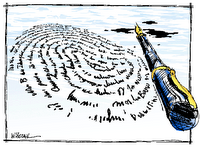
When time permits, I've been carefully skimming the approx. 30
CHC/WJ III dissertations that I recently acquired and noted at this blog. When I've discovered something of potential importance, I've made
DD (
Dissertation Dish) posts (all DD-related posts can be found by clicking on the
"dissertation" keyword in this blogs index--scroll down left-side of blog).
I just finished skimming a dissertation by one of
Dawn Flanagan's students (Kyvelos, 2003). Kyvelos reanalyzed (via CFA) the speeded tests from the WJ III/CAS validity sample (155 elementary school-age subjecxts) which was the foundation of
Keith et al.'s CHC-based WJ III/CAS SPR article (2001). At variance from the SPR publication was the inclusion of the WJ III
Retrieval Fluency and
Rapid Picture Naming Speed tests in the analysis. These tests were NOT included in the Keith et al. 2001 formal publication.
[
Conflict of interest note - I'm a coauthor of the WJ III battery]
Although no support was found for the classification of the WJ III and/or CAS speeded tests at the narrow (stratum I) ability level, the analysis did support the validity of separate broad
Gs and
Glr factors, factors with a latent factor correlation of
.74. What I find particularly interesting was the validity for a rate-based
Glr factor, which was defined by the following significant loadings:
- WJ III Retrieval Fluency = .69
- WJ III Rapid Picture Naming = .56
- CAS Expressive Attention = .30
In contrast, all other WJ III (Decision Speed, Cross Out, Visual Matching) and CAS speeded tests (Receptive Attention, Planned Connections, Planned Codes, Number Detection, Matching Numbers) all loaded on the broad
Gs factor.
Why is this interesting?
First, the most robust post-WJ III publication structural finding I've discovered (in various unpublished analyses I've conducted with the WJ III data files) is the finding that the WJ III Rapid Picture Naming (measures the ability to rapidly identify and orally name pictures of common objects) and Retrieval Fluency (measures fluency in retrieving the names of objects.. the subject is asked to state as many items as they can of three different types) tests "hang together." These two tests seem to be tapping a
rate retrieval (Glr) ability distinct from traditional
Gs tests. As reported in the broad+narrow CFA in WJ III technical manual, we did specify these two tests to represent the narrow ability of
"Naming Facility" under Glr.
- NA- Ability to rapidly produce accepted names for concepts or things when presented with the thing itself or a picture of it (or cued in some other appropriate way). The naming responses must be in an individuals long-term memory store (i.e., objects or things to be named have names that are very familiar to the individual). In contemporary reading research is ability is called rapid automatic naming (RAN)
That is...evidence was presented in the WJ III TM that these two tests measure the rate aspect (versus the "level" aspect) of
Glr. I've repeatedly found these tests grouping together in various exploratory factor analyses, multidimensional scaling analysis, cluster analysis, etc. The Kyvelos (2003) study supports this finding. I've speculated that the common ability is "
speed of lexical access"....which I first ran across in
Perfetti's reading research.
Second, the other test that loaded on this rate
Glr factor was the CAS Expressive Attention test. This task is based on the classic
Stroop task (1935) that is typically interpreted as a valid measure of i
nterference, inhibition/disinhibition, and executive control. In this task a subject must name as fast as possible (when presented with printed words in different colored fonts) the color in which the words red, blue, yellow, and green, are printed instead of reading the words themselves. Clearly such a task requires response inhibition and rapid/fluent accessing of a person's lexicon (speed of lexical access).
Bottom line - I believe, based both on published and unpublished research, that the combination of the WJ III Retrieval Fluency and Rapid Picture Naming tests measure some sort of
Glr fluency/rate ability, especially as it relates to
speed of semantic processing or s
peed of accessing one's lexicon. The association of these two WJ III tests with a CAS Stroop-like task (Expressive Attention) also suggests that response inhibition is a potentially important component for successful performance on these two WJ III tests. In other words, these two WJ III tests may measure, aside from
speed of lexical access or word retrieval fluency (possibly
some shared abilities with
RAN tasks?), aspects of executive functioning - namely, ability to deal with interference effects and response inhibition.
RE: possible WJ III measures of executive functioning, check out
recent posts re: the WJ III Pair Cancellation test.
Technorati Tags:
psychology,
school psychology,
educational psychology,
neuropsychology,
intelligence,
IQ,
IQ test,
intelligence quotient,
CAS,
WJ III,
Woodocck-Johnson,
executive function,
inhibition,
Gs,
Glr,
CHC,
CHC theoryPowered by ScribeFire.


 All the news thats fit for IQ's Corner readers:
All the news thats fit for IQ's Corner readers:








